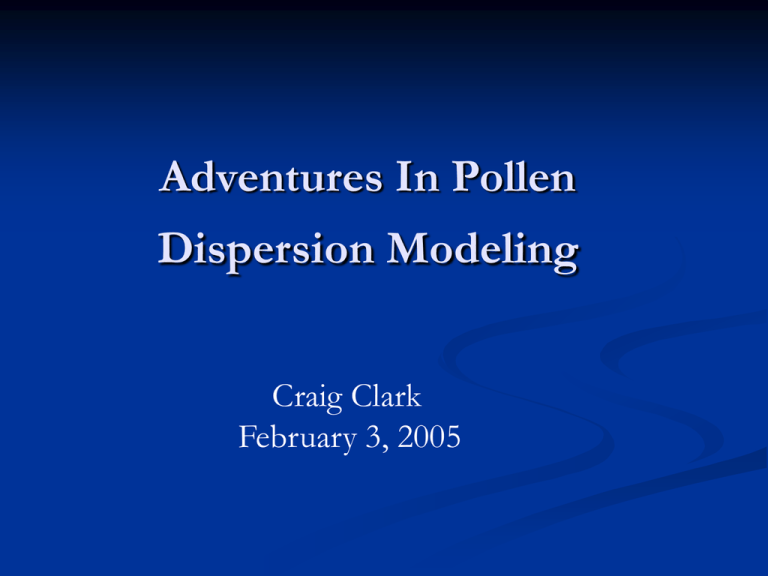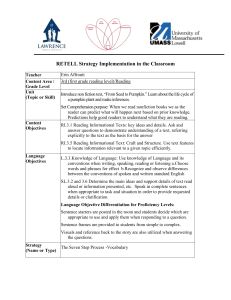Adventures In Pollen Dispersion Modeling Craig Clark February 3, 2005
advertisement

Adventures In Pollen Dispersion Modeling Craig Clark February 3, 2005 Outline Introduction to the problem Boundary layer torture and dispersion modeling Summer 2003 example The next phase: modeling of windbreak The Problem Growth of GM crops has led to concern that GM maize will outcross with nearby fields Several studies have observed deposition, but results cannot be with generalized to all field and weather conditions Numerical simulations can predict pollen dispersal in a variety of field and weather conditions Maize Pollen Dispersion Basics Maize Pollen has a large terminal velocity (~20 cm/s) Typically shed over several days – morning to afternoon peak Most pollen is deposited in or very near the source field, but a significant amount of pollen travels a much greater distance Numerical Modeling Simulated flow profiles can be generated by scaling relationships in the atmospheric surface layer (using vegetation characteristics and local wind observations) Mean and turbulent flow characteristics are provided for the Lagrangian Particle Dispersion Model u ik' (t t) u' ik (t) R ik (t) u ik'' (t), k 1,2,3 Lagrangian Particle Model Frame of reference is along the pollen particle path Particle accelerations follow a stochastic, autoregressive “random flight” approach u ik' (t t) u' ik (t) R ik (t) u ik'' (t), k 1,2,3 August 2003 Pollen collected August 6th to 12th at Knapp farm near Ames, IA Peak pollen shed and deposition from August 9 to 11 WIND ROSE PLOT Station #14848 - Knapp S, IA 10th August 2003 Wind Rose NORTH 30% 24% 18% 12% 6% WEST EAST Light SW wind Wind just strong enough that deposition will not be symmetric about the field SOUTH MODELER Wind Speed (m/s) DATE COMPANY NAME 10/20/03 > 2.50 DISPLAY UNIT 2.00 - 2.50 Wind Speed m/s 1.50 - 2.00 AVG. WIND SPEED CALM WINDS 1.00 - 1.50 1.39 m/s 0.00% 0.50 - 1.00 ORIENTATION PLOT YEAR-DATE-TIME 0.01 - 0.50 Direction (blowing from) 2003 Aug 10 - Aug 10 Midnight - 11 PM WRPLOT View 3.5 by Lakes Environmental Software - www.lakes-environmental.com COMMENTS PROJECT/PLOT NO. August 10th 2003 Knapp Field Data Knapp Log Pollen 08/10/03 Dispersive Tail • After 50m, there doesn’t appear to be any relation between log pollen concentration and distance from the field 2003 Knapp Farm Model Results Comparison of Model and Observations Log Pollen Dispersion and Model Results August 10 2003 2.5 2 1.5 1 0.5 0 0 50 100 150 Distance From Field Pollen Deposition Model Results 200 250 Comparison of Model and Observations August 10 2003 Pollen Deposition and Model Results y = 0.6536x - 0.0073 Pollen Deposition R2 = 0.8088 1 0.9 0.8 0.7 0.6 0.5 0.4 0.3 0.2 0.1 0 0 0.2 0.4 0.6 Model Results 0.8 1 The Next Phase Windbreak around will reduce wind speed over much of field and alter pollen dispersal Use Takle and Wang shelterbelt model to simulate effect of windbreak and canopy Effect of Wind Break on Wind Speed and Turbulence Effect of Windbreak and Canopy on Dispersion Effect of Bow Echo on Wind Break Conclusions Model captures majority of observed variance in August 2003 Knapp data Modeled windbreak has substantial impact on dispersal Roughness changes at field edges generate a natural shelter effect when upwind vegetation is shorter Future work: 3D shelterbelt model Acknowledgements Ray Arritt, Mark Westgate, Susana Goggi Cory Heilmann, Petrutza Caragea, James Correia Jr., Chris Anderson The wind break building crew! Boulevard Wheat Effect of Wind Break on Vertical Velocity Effect of windbreak and canopy on dispersion




